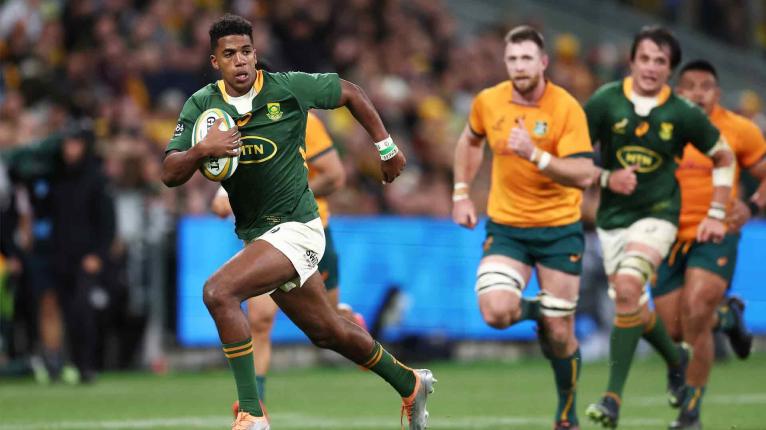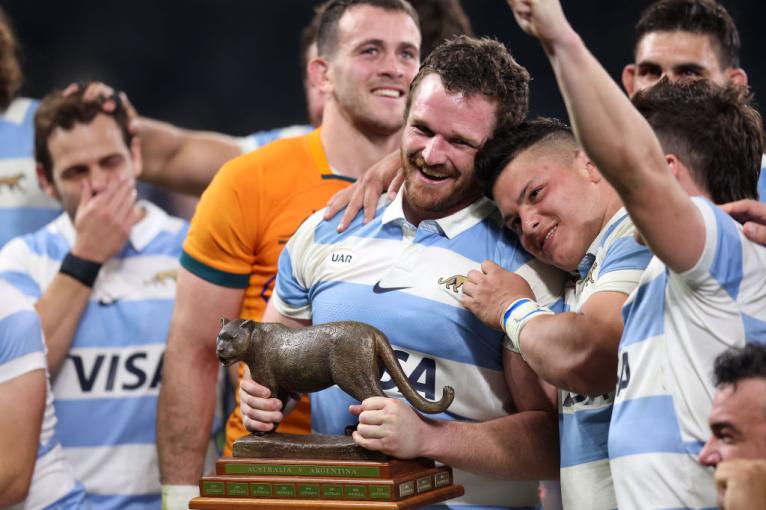An old Irish rugby joke: “The state of English rugby is frequently serious but rarely tragic; the state of rugby in Ireland is usually tragic but never serious.” It is epitomised by Willie-John McBride’s recollection of his only third game in an emerald green jersey against France in 1962. McBride played the last 30 minutes with a broken leg:
“Unbelievable. I remember removing my boot and two guys ran on with a sponge and water. They rubbed it and said: ‘You’re all right.’ You did not come off in those days – not unless you were dead.
“Afterwards I was taken to hospital and had plaster-of-Paris in Paris – all the way up to the knee.”
On his return home, Willie-John had to take a train and two buses before limping up the hill to his house in Ballyclare on that mummified leg.
The dramas in Australian rugby are rapidly approaching an ‘Irish’ state-of- affairs – usually tragic, but seldom to be taken seriously. Even when there is no game being played, the Aussies are hard it in the media, going hammer-and-tongs at one another.

After the match in Parramatta between Australia and Argentina, it was the turn of part-time defence coach of the Australian A side, and long-term Brumbies favourite ‘Lord’ Laurie Fisher to comment on the Wallabies’ lamentable defensive display at home against the Pumas:
“From watching the game, I don’t know that they have great clarity themselves at the moment.
“They have a new defensive coach [Brett Hodgson] who’s never coached rugby union, he hasn’t played rugby union.
“He is obviously working on connection and kick-chase and first-phase. Is he also talking about what is our contest policy between the 15? What do you do in our own 22?
“I saw guys having a crack, but I didn’t see a designated policy of how we’re going to get some pressure on their ball. Even close to our line, I saw Jed Holloway pull out of a contest. For goodness sake, you’ve just got to go in and make a mess of it. It’s a non-negotiable.
The ‘Australian Way’ off the field traditionally is to be honest and open to criticism, even when it hurts the most – especially when it hurts the most.
“So, I don’t know if that’s an area that they’ve addressed with any significance yet. So it’s a huge area for potential improvement.”
It is perhaps typical of the Vaudeville atmosphere currently surrounding Australian rugby that Eddie Jones chose to censure Fisher’s comments as ‘inappropriate’, before later admitting that the substance of his criticisms was entirely correct:
“I’ve got no doubt we’re not as clear about how we want to play as we want to be…
“We’re not [aligned on defence] and that’s part of the issue we’ve got at the moment. But in time we will be.
“It’s an understanding issue – understanding what we need, what decisions need to be made by the players. How much is a [collective] framework, and how much is the [individual] decision-making of the players? We’re working out the right balance.”

The ‘Australian Way’ off the field traditionally is to be honest and open to criticism, even when it hurts the most – especially when it hurts the most. If there is one quality which has set Australian sport in all its forms apart over the years, it is that capacity to absorb blunt-force trauma in its self-reflection. Australian sport digests its lessons more quickly than anyone else, and therein lies its strength – at least, up until now.
At the present time, the desire to offer false positives is impeding the ability to look things squarely in the face. Here is one example: it is an undisputed fact that the Wallabies made 200 of their 219 tackles attempted versus Argentina, with an impressive overall completion rate of 91 per cent. That statistic has been referenced and called a success in the aftermath of events.
But yoke that individual fact to several significant others, and the view changes: Australia only pilfered the ball twice out of 116 rucks set by their opponents, which meant the Pumas had a 98 per cent-plus retention rate. When you consider that one of the turnovers was handed back on the very next play, 98 per cent rises to 99 per cent. The wider outcome was 38 per cent of possession, 32 per cent of territory and less than 13 minutes of active time with ball in hand for the Wallabies. That is not enough.
The desire to reload for the next phase out in the defensive line needs to be balanced by an identification of the right time to move towards the ball after the tackle and ‘go in and make a mess of it’. This is not rugby league and the ruck is not a play-the-ball. The breakdown is a contest. As Lord Laurie rightly said, that is a non-negotiable.
You do not need to analyse beyond the first 20 minutes of the match to reach exactly the same conclusions as the Brumbies’ defence and breakdown expert, most especially in relation to the man he mentioned briefly in his commentary, Waratah Jed Holloway.
Holloway, along with Will Skelton, is one of the two biggest and most physical defenders in the Wallabies pack, and he is probably the best high ‘choke’ tackler in the Australian game – so you want to put him in position to make as many physical impacts as he can in the middle of the field, between those two 15-metre lines.
The opening sequence of the game witnessed the negative side of starting Jed Holloway at No 6 without injecting any of the positives:

In line defence, Holloway moves straight forward into the first Argentine forward pod, and that peels away the protection inside No 13 Len Ikitau, allowing the initial break. One phase later, after a driving double tackle by Allan Alaalatoa and Dave Porecki, Holloway has his chance to balance the account. He can plough past Tomás Lavanini, who has his back turned to the defence, and into Thomas Gallo, who already has his hands full with a reloading Porecki. Instead, he just sits and waits passively, for the next play to unfold.
This became the template for both Holloway’s individual defensive involvement, and Australia’s collective framework on the day:

Alaalatoa shows the kind of aggression the Lord would have heartily applauded to win the ball at the breakdown; but the reaction of Richie Arnold, in particular, is simply far too slow to secure it and confirm the turnover. That in turn allowed Argentina to resume a slow 16-phase grind all the way to the Australian goal-line.
It is the actions, or rather the non-actions of Jed Holloway during this sequence which are of special interest. Let’s resume the flow of events on 5th phase:

There is only one Argentine centre sitting on top of the ruck, with Lavanini once again forced to run backwards in order to add himself to the cleanout, so Holloway has a terrific opportunity to drive straight ahead in a physical mismatch and ‘make a mess of it’. Instead, he stays out in line, still struggling to make up ground inside Quade Cooper and offfering an ineffective flail on the tackle attempt. That is twenty metres run from midfield out to the right, all for nothing.
By the following play, he was running all the way back to left after missing out on another chance to make an impact at source:

Once again, Lavanini is neither facing north-south nor looking at the opposition, which means the Argentine scrum-half is momentarily exposed at the base, but Holloway is clearly under orders to remain at his post. That permits the Pumas to spin the ball wide right and pick up more ground unhindered. Another 30 or more metres run, for little or no return.
The coup de grâce arrived two phases later:

Holloway has a shot at stepping straight through the centre of the ruck after staying on his feet at the tackle area, but he thinks twice about it and pulls out instead. Only that haunting echo of the Lord’s obvious frustration remains: “Even close to our line, I saw Jed Holloway pull out of a contest. For goodness sake, you’ve just got to go in and make a mess of it. It’s a non-negotiable.” As Laurie Fisher rightly pointed out, there was no clear and obvious policy on tackle and post-tackle contest between the two 15m lines, and that is Jed Holloway’s area of speciality: High tackle technique, hard work after first contact is made. None of that pertained.
Ironically, Holloway made his one stop of the entire 16-phase sequence shortly afterwards, with the final act leaving a more characteristic memory in its backwash – Holloway still tracking across the field, trying hopefully to link up with the Australian backs outside him:
Stan Sport commentator Justin Harrison called it a ‘great defensive effort from this Wallaby side’, but over the piece it just meant that Australia had to make far more tackles than they needed to. The Wallabies did not attack the ball at source and they did not make best use of the defensive resources at their disposal in the process.
Despite Eddie Jones’ testy reaction, long-time Brumbies’ defensive specialist Laurie Fisher was well within his rights, and fully justified to make the post-match comments in the podcast afterwards. Direct, ferocious self-criticism is a part of the Australian way. It is up to Brett Hodgson to prove that he is capable of both constructing, and operating an international-quality defence in union, and make the most of the people he has available to him.
If forwards like Jed Holloway are selected, they need to be put in the positions where they can make an impact. If they can make high tackles effectively, let them make them. If they can step across and dominate the centre-line of the ruck, for goodness sakes encourage them to do just that. Blow up those attacks at source before they ever reach the edge of the field, in between the two 15’s. Choose the red pill, dive down the rabbit-hole and embrace rugby reality as it is, not as you wish it to be. That is the best lesson of Australian sport, after all.


Great stuff again Nick. Eddie seems to have a habit of preprogramming players to not use their strengths. For example the poms and Ikitau kicking good ball away and now this.
He just doesn't have the support staff JD - is there one AB assistant you'd swap for his WB equivalent? No. The Lord would have told him face to face.
Hi Nick, not an easy read for a Jed fan, yet I take your point about the coaching approach, or lack thereof. He might have also been caught a bit short after some weeks without a game. I expect a bigger game this week, although it will of course have to be constructed against a bigger opposition.
I don't attach any blame whatsover to Jed CS. In that one near the line, you can see he's backing off when his instincts are telling him to challenge for the ball directly. Not telling, screaming at him.
Hi Nick did you see the selection of our team vs MIB. I would replace Frosty on the bench with Richie A and put Matty P in at starting lock. I would move JP to fullback and replace Lenny with either a J Flook or Joey Walton which is a big risk because of inexperience at this level but since Perese is there his connection with Marky Mark would have at least bring a little more comfort. It is shame Hodgey is not there.
I'd have had Foketi at 13, started Frost at 6 and swap him with Holloway at 4, with Philip on bench duty! Tempted to start Jordie P. at 15 too...